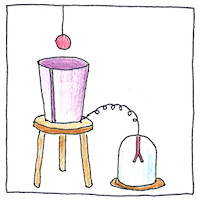Michael Faraday
electromagnetism

|
Faraday cage
A conducting enclosure shields electromagnetic radiation if its holes are smaller than the wavelength of the radiation. The radiation induces an equal charge and opposite polarity on the surface of the cage nearer to the radiation source. and an equal charge of the same polarity on the far surface, neutralizing the radiation inside.
Corks and cans
In 1755, Benjamin Franklin dipped an uncharged cork suspended on a silk thread into an insulated charged can, and found the cork was not attracted to the can as he thought it would be. An equal charge with opposite polarity builds up on the inside of the can. In 1843, Michael Faraday dipped a charged brass sphere into an insulated uncharged pewter ice pail. An equal charge with the same polarity builds up on the outside of the pail.
Equilibrium in flux
Any force induces an opposite force to neutralize the threat. Like a child who hears but won’t listen, who says OK but won’t obey, a pewter shell protects the soul.



An exterior electromagnetic field generates a current in an ungrounded Faraday cage to distribute electrons until the charged surfaces generate an opposing field to cancel the field inside the cage. Outside the cage, however, the field appears to travel through the cage.
A grounded Faraday cage still cancels an exterior field so that it has no effect inside the cage, but doesn’t make the cage seem transparent to the field, and it’s safe for someone on the opposite side of the field to touch the surface of the cage.
See also in The book of science:
Readings in wikipedia: